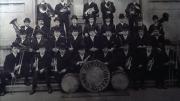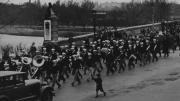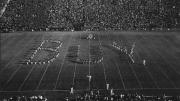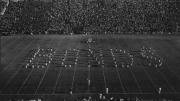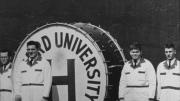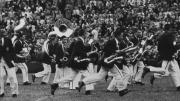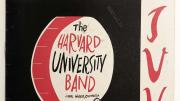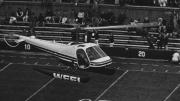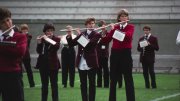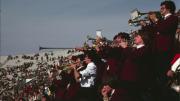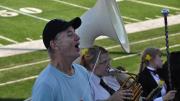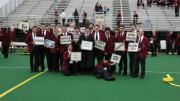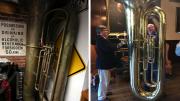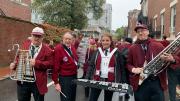When the Harvard University Band parades through Harvard Square for the football game against Cornell this Saturday, onlookers may do a double-take. To celebrate the band’s hundredth anniversary, the usual contingent of 60 student musicians will likely swell to more than six times that number, thanks to the masses of band alumni and alumnae expected to join them for the march and a weekend of reunion festivities.
For its centennial concert this Friday night, the band will literally blow its own horn: a rare seven-foot subcontrabass tuba known to musicologists and antiquarians as “The Harvard Tuba.” Newly restored for the occasion, the giant instrument will be featured in the world premiere of “Caprice for a Great Big Tuba” by Lewis J. Buckley, with Mike Roylance, principal tuba player for the Boston Symphony Orchestra, as soloist. Harvard Band director Mark E. Olson will conduct.
Formed in 1919 to replace the College’s Banjo and Mandolin Society, the band began as a group that played football songs in front of Widener Library and passed the hat among students to buy uniforms. Today the University Band is an extensive musical enterprise consisting of a football band, a concert band, a wind ensemble, and two jazz bands. Many students play in more than one group.
All together, these units give nearly 100 performances year-round on a combined annual budget exceeding $100,000, more than a third of which comes from the Harvard Band Foundation, a nonprofit organization supported by former band members. The remainder is funded by the Office of the Arts, the music department, the athletic, Commencement, and alumni association offices, and by individual contributions and ticket sales.
Over the years the band has cultivated a dual personality. The football band is known for its creative—and often irreverent—halftime shows and Lampoon-like hijinks. Decrying military-style precision marching, it pioneered the “scramble” approach of running helter-skelter into formation. It has awakened Yale students with a “serenade” at 3 a.m. for which it was arrested by the New Haven police, and has held impromptu concerts at such high-visibility locations as the U.S. Capitol steps. The concert band, meanwhile, has performed serious classical works in the nation’s most prestigious concert halls. Hailed for its musicianship, it joined the Columbia University Band at Carnegie Hall in 1965 for the New York premiere of “Emblems,” by Aaron Copland, D.Mus. ’61, with the composer in the audience, and for works by Holst, Hindemith, Mendelssohn, and Prokofiev.
Band director Olson calls the band “the official University spirit unit.” It performs at Commencement and other ceremonial occasions, welcomes guests and celebrities to Cambridge, and, says Olson, “encourages alumni to raise song”—not to mention give money—“to Harvard.”
Band members past and present invariably speak of the band’s spirit and camaraderie when asked why they chose to join. In addition, the band’s links to professional musicians, and its opportunities for undergraduates to gain leadership experience in conducting and management, also appeal.
Notable early directors include Leroy Anderson ’29, composer of “Sleigh Ride” and “Syncopated Clock,” who composed intricate contrapuntal medleys of the fight songs of Harvard and its Ivy League rivals, some still performed, and Malcolm H. Holmes ’28, dean of the New England Conservatory of Music, who initiated the band’s recording work and led it through its first concert season in 1946. Under Holmes’s baton, the band’s highly polished performances earned it the accolade “best in the business” from The New Yorker.
Traditionally, the band—which is still entirely student-managed—paid a professional conductor an annual stipend of $1,000 for part-time services and maintained financial and administrative independence from the University, believing that if Harvard paid the piper, it would also call the tune. But in 1960, facing both a sizable deficit and the need to hire a new director, its leaders decided to search for a full-time director who could provide strong musical leadership and put the band back on its feet financially. To give the position added status (and save the $1,000 fee), the bandsmen boldly recommended that the new director, James A. Walker, A.M. ’63, be appointed to the Harvard faculty—and McGeorge Bundy, then dean of the Faculty of Arts and Sciences, agreed, giving Walker the title “director of the University Band.” Walker, who conducted that 1965 Carnegie Hall concert, placed his players in the vanguard of American ensembles performing contemporary music for concert band.
The football band, meanwhile, took increasingly to social commentary and avant-garde humor at its halftime shows, beginning during the 1960s, sometimes verging on the lewd and tasteless. Ever since a 1983 show about the bombing of the U.S. Marine barracks in Lebanon and the Soviet Union’s downing of a Korean Airlines jet, University officials have insisted that the band submit plans for those performances in advance.
The band’s most celebrated caper came in 1976, when it landed a helicopter on the 50-yard line at Soldiers Field during the game against Brown, and student conductor Jack Barbash ’78, disguised as Leonard Bernstein ’39, D.Mus. ’67, emerged in concert attire to lead what the announcer called “The New York Philharmonic Marching Band.” Many in the crowd believed Barbash was indeed the real-life composer and conductor. “It was presented as plausible,” says Rick Minard ’77, originator of the helicopter stunt, and “the audience went nuts.” (Despite receiving advance approval for the show, Minard was visited the next day by a Harvard administrator who called the stunt “stupid, dangerous, and reckless.” Minard admits he was chastened by the experience.)
Among the band’s recent triumphs was having a group of its members chosen to open the soundtrack of the film On the Basis of Sex, based on the early life and career of Supreme Court Justice Ruth Bader Ginsburg, L ’59, LL.D. ’11, including her time at then nearly all-male Harvard Law School. Daniel Stiepleman, the film’s screenwriter and producer, wanted the band to record “Ten Thousand Men of Harvard” to make clear from the start that the film was going to be fun. “The rah-rah tone of the fight song and the contextual irony of the lyrics”—sung by the all-male Harvard Glee Club—“achieved that,” he believes. The soundtrack also included the song’s satirical dog-Latin translation, Illegitimum non carborundum (“Don’t let the bastard grind you down”), which the band has adopted as its motto.
But sexism at Harvard was not limited to the Law School; it ruled the Harvard University Band for 51 years. The band did not admit its first female musician, Sally Dorfman Sirota ’71, until February 1970, and that was only to enlarge the wind section of the concert band. “The football band is not admitting women,” then band manager James D. Dill ’71 told The Harvard Crimson, because “our looseness and lewdness are just too sacred to us. We play at boxing matches and hockey games and our annual banquet has always been a stag-type affair.”
Sirota, a flute player, did not consider herself a crusader. “There might be other places where my crusading energies can be more valuable, but I just like the band’s spirit,” she said at the time. By that fall semester, though, the football band had relented. Dill, the Crimson noted, “felt it was no longer fair to girls to exclude them.”
Diane Wasserman Feldman ’80, the band’s first female manager, observes that the band “was adapting to a new coed environment. Before me, there were quite a number of women active in the band.” Choosing a female manager, she adds, “was just one step in the evolution of the organization.” Today, according to manager Lucaian Al-Tariq ’20, 42 percent of the band’s 105 members are female, 52 percent are male, and 6 percent are gender nonconforming.
When football season rolls around, joint pre-game concerts with musicians from the opposing Ivy League schools are a staple of the Harvard band schedule. The historic Harvard-Yale rivalry in particular is deeply felt by their respective bands. Yale musicians once stole “Bertha,” Harvard’s iconic seven-foot bass drum, and the Harvard Band insists on spelling Yale with a lower case “y.” Yet the two bands form an interlocking “H” and “Y” while jointly performing the National Anthem before the Game each year, and Yale alumni recall those games with high praise for the Harvard Band’s musicianship. Mitch Silver, a former trumpeter for the Yale Band, says, “Harvard’s brass section, my particular interest, was so good—not just on the field but in the stands, when they would play those Bach chorales and trumpet voluntaries ending with the shouted word ‘Fight!’”
At Saturday’s Cornell game, band musicians young and old will be cheering for a Harvard victory. But even when its team loses, the Harvard University Band remains, as one journalist put it, “undefeated, untied, and unscored upon.”
